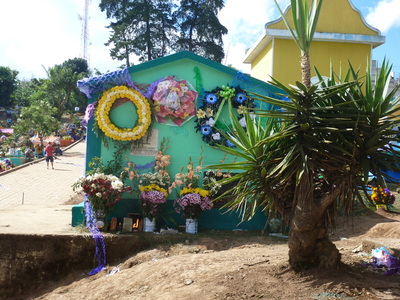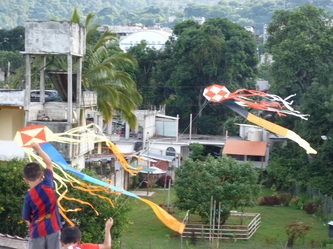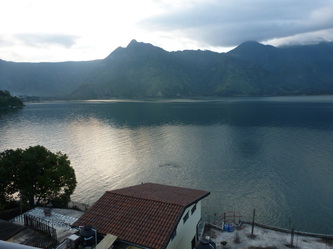Cemeteries, Ceremonies and Sacred KitesThis was the third small group cultural tour I’ve led to the Kachiquel Maya pueblo of Sumpango to observe and participate in their unique celebration of the Day of the Dead, featuring los barriletes gigantes, the Giant Kites. We were very fortunate to be joined again by master kitemaker and international kite exhibitor, Julio Asturias, who over my years of living in Guatemala has truly become a dear and inspiring friend. It is thanks to his willingness to generously share his time, his knowledge and enthusiasm as well as his practical guidance that this tour offers such depth.
RIDING THE WIND in SAN PEDRO LA LAGUNA We are just winding down from the four month rainy season. The rain no longer sends daily rivers rushing down the steep hills, straight through town and into the lake. The sunny mornings last later into the afternoon before gentler rains wash over us. The densely carpeted ancient volcanoes are a well watered green, their slopes fertile arms which hold the Tzu’tujil Maya pueblo of San Pedro La Laguna cradled against towering Volcan San Pedro.
In the afternoon, since about the middle of September, the winds rise. The cloud gathering sky becomes a backdrop for streaming colors which swoop and dash and sometimes fly higher than the tops of the volcanos, the kites like brilliantly colored dragons in their length and sinuous movements. I've gathered together some photos from the three day Giant Kite Cultural Tour that I led with master kitemaker, Julio Asturius in 2011 and 2012 in the Kaqchikel Maya pueblo of Sumpango over the Day of the Dead. The tradition of los barriletes gigantes began when the pueblo was plagued by misfortune. In consulting the local brujos, the town was advised to make kites and that the sound of the wind rustling the fringe, those trailing paper flechas on the edges of the kite, the evil spirits would be frightened away and not bother the town. Since then the kites have become bigger and more innovative in form, combining ancient Maya cosmology with contemporary messages. Over 600 people in Sumpango work every night for over four months making these kites from tissue paper and glue. Kites smaller than 6 meters are flown in an afternoon competition. For the larger kites, the challenge is to successfully mount these delicate and enormous designs on a lattice of bamboo. Of course our own efforts at kitemaking were more modest, but satisfying nonethess. Followed by a private Mayan shamanic ceremony with Sumpango nana ,Delphina. Like many other towns throughout Latin America, Sumpango also celebrates Dia de los Muertos by cleaning and decorating the cemetary with flowers. On November 2, families spend the day together at the cemetaries, preparing lunch there, remembering the ancestors and of course, flying kites. Join us this year and see what the kitemakers have in store for 2013! Eighty-five thousand years ago, the spectacular twin Los Chocoyos volcanos erupted in a major seismic event which spread ash from Guatemala as far south as Panama and formed the volcanic crater that today holds Lago Atitlán. Renowned as one of the world’s most beautiful lakes, Lago Atitlán is twelve miles long and over a thousand feet deep, held by mountainous folds of trees, coffee and corn. Rising above this spectacular setting are the volcanos San Pedro, Santiago and Toliman. Beneath them Tz’utzujil Maya pueblos with concrete houses in yellow, pink and blue are interspersed with hives of traditional adobe and tin roofed homes, tumbling bougainvillea and bananas drooping with crowded hands of fruit. On the lake fishermen stand paddling shallow wooden boats, unfolding hand lines as they roll their wrists one over the other. In 1995 I visited Santiago Atitlán as a member of Vashon’s sister city committee. Sixteen years later I returned to Lago Atitlán and revisited Santiago and neighboring San Pedro La Laguna. I was afraid the traditional Maya way of life had been ruined by modern commercialism and inclusion on the gringo trail. San Pedro has indeed changed hugely since the day I required a guide to lead me down the narrow paths through coffee and corn to find a hidden hotel . But in this 96% Tzu’tujil pueblos, Maya identity and tradition continues to live, even as the town has graciously grown to meet the needs of budget visitors from around the world who come to learn Spanish, to live in a Maya homestay, to volunteer, or like me, in search of a more connected and vital daily life. As a writer with a PhD in Creativity and Communication, I am passionate about “live” experiences Hey, there's still room on the bus, even though there are six people across and people standing in the aisle! And so the story of Guatemala's public transportation, fondly known as the "chicken bus," where chickens are sometimes among the passengers and riders travel in recycled elementary school buses from the U.S. You can find my article with useful tips and customs on mastering Guatemala's unique system of transport by checking the link for Antigua's Que Pasa August 2013 magazine (p.18) http://www.quepasaenantigua.com/ or read it right here in PDF format! Thousands of visitors come to Guatemala every year in order to learn Spanish, the second most popular language in the world -- the first being English. Spanish is the official language of 21 countries, so think of where you can go and the conversations you can have if you hone your Spanish, to say nothing of how good it is for your brain to learn! I've been studying Spanish intensively since moving to Guatemala, and Bright Future Global Tours can set you up with a great Spanish school anywhere you want to be in Guatemala. In the meantime, here's the link to my article on learning immersion spanish which was published in Antigua's El Revue magazine, July, 2013. Here's the link so you can see it in El Revue's flip book format http://issuu.com/revue/docs/revue2013-07/59?e=1183759%2F3825444 or you can read it in PDF format right here. Contrary to much popular use, the plural of Maya is Maya not Mayan. There are 22 distinct groups of Maya in Guatemala, each with their own indigenous language. The Cakchiquel and Tz'utujil Maya have lived on the lands surrounding Lake Attitlan for 4, 000 years, where they settled after migrating from Chichen-Itza and Petén in the north. For 2,000 years they fought each other for possession of the lake. And then, like Solomon, they divided it down the middle, so that the Tz,utujil live in the south and the Cakchiquel in the north.
Eighty-five thousand years ago, the spectacular twin los chocoyos volcanos erupted, a major seismic event which spread ash from Guatemala as far south as Panama and formed the volcanic crater that today holds Lago Atitlán. Renowned as one of the world’s most beautiful lakes, Lago Atitlán is twelve miles long and over a thousand feet deep, held by rising folds of trees, grasses and corn that end in a jagged volcanic rim. Rising above this already spectacular setting are the volcanos San Pedro, Santiago and Toliman. Beneath them are Tz’utzujil pueblos with concrete houses in yellow, pink and blue and stately windows framed with Guatemalan hardwood. These are interspersed with beehives of adobe and tin roofed homes, patches of corn, tumbling bougenvillae, and bananas pregnant with crowded hands of fruit.
I hope you will check out my interview with kitemaker Julio Asturias http://www.grupoquepasa.com/interview-with-barriletero-julio-roberto-asturias-chiquito/ in Que Pasa magazine. Julio is a wonderful friend and the guide for the Sumpango Day of the Dead Giant Kite Festival part of the Giant Kites and Ancient Temples 2013 cultural tour.
And read my article El Revue magazine about the history and making of the giant kites! http://issuu.com/revue/docs/revue201210/87 And then take a look at this years Giant Kites & Ancient Temples Tour and come see for yourself these amazing works of sacred art made from tissue paper and glue. |
Louise "Luisa" Wisechild, PhDI first visited Guatemala in 1995 as a member of the Vashon Island sister city delgation to Santiago de Atitlan, Guatemala. Archives
October 2023
Categories
All
|




















 RSS Feed
RSS Feed

